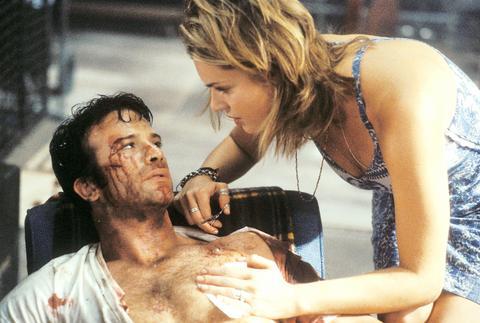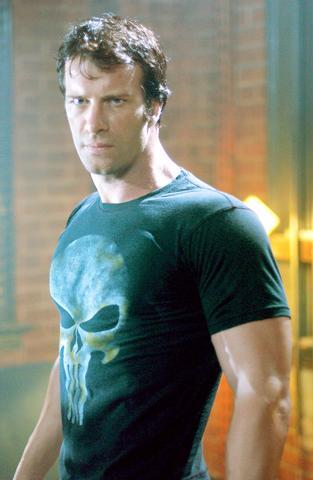The Punisher, a Marvel Comics crime fighter introduced in 1974, is unusual among superheroes (especially Marvel colleagues like Spiderman, the Hulk and the X-Men) for his lack of super powers. His grim, brutal crusade against sundry wrongdoers is enabled not by spider sense or superhuman strength, but by guns, military training and righteous fury.
Jonathan Hensleigh's movie version of the Punisher's origins stays true to its hero by being similarly stripped-down, efficient and mean. At a time when comic-book film adaptations have become showcases for the latest computer-assisted special effects, The Punisher is a straightforward, somewhat old-fashioned action picture, full of gunfire and hand-to-hand combat, leading to a climax in which several dozen cars explode. The only unusual gadget the hero employs is a portable fire hydrant, which may have some potential as a merchandising tie-in.

PHOTO COURTESY OF E MOVIE
In any case, The Punisher, loaded with grim, sadistic violence and more than two hours long, certainly lives up to its name. Played with unsmiling determination by Tom Jane, who exhibits none of the loose charm he showed as Mickey Mantle in 61* on HBO, the Punisher starts out as Frank Castle, a Special Forces veteran just retired from the FBI His last undercover operation resulted in the accidental death of a suspect who happens to have been the beloved son of a ruthless nightclub owner, money launderer and corporate mogul named Howard Saint.

As Saint, John Travolta, a lock of long hair perpetually threatening to fall over his eyes, basically reprises his villainous turn from the toxic Swordfish a few years back, with family feeling replacing greed as the character's primary motive for evil-doing.
Urged on by his wife (Laura Harring), Saint takes revenge on Castle by wiping out his whole extended family during a reunion in Puerto Rico.
Among the dead are Castle's wife (Samantha Mathis), father (Roy Scheider) and young son (Marcus Johns). Mother and son are shown in desperate and prolonged flight from their fates in a scene meant to emphasize the depraved cruelty of the bad guys and to justify the bloody payback that follows.
Throughout the picture, we are repeatedly invited to see just how much pleasure the Punisher's enemies -- in particular, Saint's right-hand baddie, Quentin Glass (Will Patton) -- take in inflicting pain on their victims, so that we can savor the prospect of punishment to follow. But the moral boundary that separates the Punisher -- or, for that matter, the filmmakers -- from his prey is vaporous, since his acts of vengeance match or exceed the original crimes in their grisly ingenuity.
Of course, to make such a point is to entertain nuances and distinctions for which The Punisher has no use. Its lack of subtlety is clearly a point of pride, and Hensleigh's flat-footed, hard-punching style has a blunt ferocity that makes Kill Bill look like In the Bedroom.
A few set pieces were clearly meant to have a grisly, Tarantinoesque wit; it hardly seems coincidental that the movie's coldblooded torture artiste is named Quentin. But lightness is not among Hensleigh's gifts. Making his directorial debut after a successful run as a screenwriter and producer (on projects like Die Hard With a Vengeance, Jumanji and The Rock) he has clearly conceived The Punisher as a throwback to the leathery, angry urban revenge movies of the 1970s.
In the Dirty Harry and Death Wish pictures of that era -- also the time of the Punisher's comic-book birth -- gracelessness functioned as a sign of macho integrity. The movie comes closest to honoring this tradition in its less operatic sequences (and in one that involves a wall-smashing fight scored to La donna mobile), which is also when it approaches the moodiness and eccentricity of the best Marvel comics.
The Punisher, holed up in a warehouse in a gritty part of Tampa, is befriended by his neighbors, three bohemian misfits played by Ben Foster, Jon Pinette and Rebecca Romijn-Stamos. Their quirky harmlessness and easy recognition of Castle as a fellow outsider give a touch of sweetness and humanity to a movie that is otherwise remorselessly ugly and punishingly inhumane.

This month the government ordered a one-year block of Xiaohongshu (小紅書) or Rednote, a Chinese social media platform with more than 3 million users in Taiwan. The government pointed to widespread fraud activity on the platform, along with cybersecurity failures. Officials said that they had reached out to the company and asked it to change. However, they received no response. The pro-China parties, the Chinese Nationalist Party (KMT) and Taiwan People’s Party (TPP), immediately swung into action, denouncing the ban as an attack on free speech. This “free speech” claim was then echoed by the People’s Republic of China (PRC),

Exceptions to the rule are sometimes revealing. For a brief few years, there was an emerging ideological split between the Democratic Progressive Party (DPP) and Chinese Nationalist Party (KMT) that appeared to be pushing the DPP in a direction that would be considered more liberal, and the KMT more conservative. In the previous column, “The KMT-DPP’s bureaucrat-led developmental state” (Dec. 11, page 12), we examined how Taiwan’s democratic system developed, and how both the two main parties largely accepted a similar consensus on how Taiwan should be run domestically and did not split along the left-right lines more familiar in

Specialty sandwiches loaded with the contents of an entire charcuterie board, overflowing with sauces, creams and all manner of creative add-ons, is perhaps one of the biggest global food trends of this year. From London to New York, lines form down the block for mortadella, burrata, pistachio and more stuffed between slices of fresh sourdough, rye or focaccia. To try the trend in Taipei, Munchies Mafia is for sure the spot — could this be the best sandwich in town? Carlos from Spain and Sergio from Mexico opened this spot just seven months ago. The two met working in the

Many people in Taiwan first learned about universal basic income (UBI) — the idea that the government should provide regular, no-strings-attached payments to each citizen — in 2019. While seeking the Democratic nomination for the 2020 US presidential election, Andrew Yang, a politician of Taiwanese descent, said that, if elected, he’d institute a UBI of US$1,000 per month to “get the economic boot off of people’s throats, allowing them to lift their heads up, breathe, and get excited for the future.” His campaign petered out, but the concept of UBI hasn’t gone away. Throughout the industrialized world, there are fears that